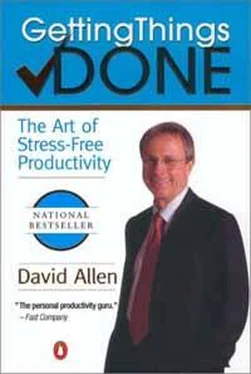The Critical Factor of a Filing System
A simple and highly functional personal reference system is critical to this process. The filing system at hand is the first thing I assess before beginning the workflow process in anyone's office. As I noted in chapter 2, the lack of a good general-reference sys tern can be one of the greatest obstacles to implementing a personal management system, and for most of the executives I have personally coached, it represents one of the biggest opportunities for improvement. Many times I have driven to the local office-supply store with a client and bought a filing cabinet, a big stock of file folders, and a labeler, just so we could create an appropriate place in which to put two-thirds of the "stuff" lying around his/her desk and credenza and even on the office floors.
If your filing system isn't fast, functional and fun, you'll resist the whole process.
We're concerned here mostly with general-reference filing— as distinct from discrete filing systems devoted to contracts, financial information, or other categories of data that deserve their own place and indexing. General-reference files should hold articles, brochures, pieces of paper, notes, printouts, faxes—basically anything that you want to keep for its interesting or useful data and that doesn't fit into your specialized filing systems and won't stand up by itself on a shelf (as will large software manuals and seminar binders).
If you have a trusted secretary or assistant who maintains that system for you, so you can put a "File as X" Post-it on the document and send it "out" to him or her, great. But ask yourself if you still have some personally interesting or confidential support material that should be accessible at any moment, even when your assistant isn't around. If so, you'll still need your own system, either in your desk or right beside it somewhere.
Success Factors for Filing
I strongly suggest that you maintain your own personal, at-hand filing system. It should take you less than one minute to pick something up out of your in-basket or print it from e-mail, decide it needs no action but has some potential future value, and finish storing it in a trusted system. If it takes you longer than a minute to complete that sequence of actions, you have a significant improvement opportunity, since you probably won't file the document; you'll stack it or stuff it instead. Besides being fast, the system needs to be fun and easy, current and complete. Otherwise you'll unconsciously resist emptying your in-basket because you know there's likely to be something in there that ought to get filed, and you won't even want to look at the papers. Take heart: I've seen people go from resisting to actually enjoying sorting through their stacks once their personal filing system is set up and humming.
You must feel equally comfortable about filing a single piece of paper on a new topic—even a scribbled note—in its own file as you would about filing a more formal, larger document. Because it requires so much work to make and organize files, people either don't keep them or have junked-up cabinets and drawers full of all sorts of one-of-a-kind items, like a menu for the local take-out cafe or the current train schedule.
Whatever you need to do to get your reference system to that quick and easy standard for everything it has to hold, do it. My system works wonderfully for me and for many others who try it, and I highly recommend that you consider incorporating all of the following guidelines to really make reference filing automatic.
Keep Your General-Reference Files at Hand's Reach Filing has to be instantaneous and easy. If you have to get up every time you have some ad hoc piece of paper you want to file, you'll tend to stack it instead of filing it, and you're also likely to just resist the whole in-basket process (because you subconsciously know there's stuff in there that might need filing!). Many people I have coached have redesigned their office space so they have four general-reference file drawers literally in "swivel distance," instead of across their room.
One Alpha System I have one A—Z alphabetical filing system, not multiple systems. People have a tendency to want to use their files as a personal organization system, and therefore they attempt to organize them by projects or areas of focus. This magnifies geometrically the number of places something isn't when you forget where you filed it. One simple alpha system files everything by topic, project, person, or company, so it can be in only three or four places if you forget exactly where you put it. You can usually put at least one subset of topics on each label, like "Gardening— pots" and "Gardening—ideas." These would be filed under G.
Currently I have four file drawers for my general-reference files, and each is clearly marked on the outside—"A-E," "F-L," and so on—so I don't have to think about where something goes once it's labeled.
Every once in a while someone has such a huge amount of reference material on one topic or project that it should be put in its own discrete drawer or cabinet. But if it is less than a half a file drawer's worth, I recommended including it in the single general alphabetical system.
Have Lots of Fresh Folders I keep a giant stack of fresh, new file folders instantly at hand and reachable from where I sit to process my in-basket. Nothing is worse than having something to file and not having an abundance of folders to grab from to make the process easy. At any given time I want to have an inventory of almost half a file drawer full of unused or reusable folders. Rule of thumb: reorder when the number drops below a hundred.
Keep the Drawer Less Than Three-Quarters Full Always try to keep your file drawers less than three-quarters full. If they're stuffed, you'll unconsciously resist putting things in there, and reference materials will tend to stack up instead. If a drawer is starting to get tight, I may purge it while I'm on hold on the phone.
I know almost no one who doesn't have overstuffed file drawers. If you value your cuticles, and if you want to get rid of your unconscious resistance to filing, then you must keep the drawers loose enough that you can insert and retrieve files without effort.
Some people's reaction to this is "I'd have to buy more file cabinets!" as if that were something horrible. Help me out here. If the stuff is worth keeping, it's worth keeping so that it's easily accessible, right? And if it's not, then why are you keeping it? It's said that we're in the Information Age; if there's any validity to that, and if you're doing anything that hinders your usage of it... not smart.
You may need to create another tier of reference storage to give yourself sufficient working room with your general-reference files at hand. Material such as finished project notes and "dead" client files may still need to be kept, but can be stored off-site or at least out of your work space.
Label Your File Folders with an Auto Labeler Typeset labels change the nature of your files and your relationship to them. Labeled files feel comfortable on a boardroom table; everyone can identify them; you can easily see what they are from a distance and in your brief-case; and when you open your file drawers, you get to see what looks almost like a printed index of your files in alphabetical order. It makes it fun to open the drawer to find or insert things.
Perhaps later in this new millennium the brain scientists will give us some esoteric and complex neurological explanation for why labeled files work so effectively. Until then, trust me. Get a labeler. And get your own. To make the whole system work without a hitch, you'll need to have it at hand all the time, so you can file something whenever you want. And don't share! If you have something to file and your labeler's not there, you'll just stack the material instead of filing it. The labeler should be as basic a tool as your stapler.
Читать дальше











